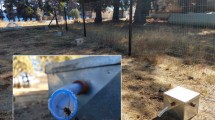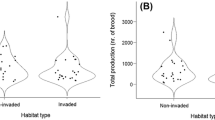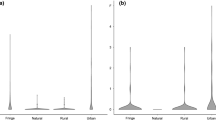Abstract
Colony foundation modes play a key role in social insect societies as they strongly impact colony survival. In subterranean termites, we do not yet know which factors most influence the early stages of colony foundation since studies on the topic are scarce. In the present study, we examined how variation in life-history traits can influence colony foundation success in two European termite species: Reticulitermes grassei, an indigenous, and R. flavipes, an invasive. We conducted an experiment in which we observed the development of colonies founded by 165 royal pairs on a weekly basis over a 6-month period. Several key results emerged: (1) survival rates of royal pairs were lower in R. grassei; (2) R. grassei pairs laid fewer eggs; and (3) all castes contained fewer individuals in R. grassei colonies, but (4) their timing of appearance are similar for both species. Overall, R. grassei pairs seemed less robust and produced fewer offspring. To our knowledge, our study is the first to describe the foundation of R. grassei incipient colonies in detail over a 6-month period. We also discovered new information about R. flavipes’ colony foundation. The data suggest that the two species have different levels of colony foundation success, resulting in differences in colony development. This finding could help explain the invasiveness of R. flavipes. Our study contribute to our understanding of the spread of two termite pest species and shed light on critical steps in the colony foundation process.



Similar content being viewed by others
References
Adam RA, Mitchell JD (2009) Energetics and development of incipient colonies of the harvester termite, Trinervitermes trinervoides (Sjöstedt) (Termitidae, Nasutitermitinae). Insect Soc 56:21–27
Argoud M, Mocotte J, Sternalski R (1982) Mise au point d’une microtermitière de laboratoire destinée à produire un matériel biologique de qualité pour rechercher et contrôler des produits de préservation du bois. Bois For Trop 196:46–50
Austin JW, Szalanski AL, Scheffrahn RH, Messenger MT, Dronnet S, Bagnères A-G (2005) Genetic evidence for the synonymy of two Reticulitermes species: reticulitermes flavipes and Reticulitermes santonensis. Ann Entomol Soc Am 98:395–401
Bagnères A-G, Clément J-L, Blum MS, Severson RF, Joulie C, Lange C (1990) Cuticular hydrocarbons and defensive compounds of Reticulitermes flavipes (Kollar) and R. santonensis (Feytaud): polymorphism and chemotaxonomy. J Chem Ecol 16:3213–3244
Büchli H (1958) L’origine des castes et les potentialités ontogéniques des termites européens du genre Reticulitermes (Holmgren). Ann Sci Nat Zool 20:263–429
Calleri DV, Rosengaus RB, Traniello JFA (2005) Disease and colony foundation in the dampwood termite Zootermopsis angusticollis: the survival advantage of nestmate pairs. Naturwissenschaften 92:300–304
Chouvenc T, Basille M, Li HF, Su NY (2014) Developmental instability in incipient colonies of social insects. PLoS One 9:e113949
Chouvenc T, Basille M, Su NY (2015) The production of soldiers and the maintenance of caste proportions delay the growth of termite incipient colonies. Insect Soc 62:23–29
Clément J-L (1982a) Phéromones d’attraction sexuelle des termites européens du genre Reticulitermes: mécanismes comportementaux et isolements spécifiques. Biol Behav 7:55–68
Clément J-L (1982b) Variabilité biométrique inter et intraspécifique des termites européens du genre Reticulitermes (Isoptères). Arch Zool Exp et Gén 122:397–410
Clément J-L, Bagnères A-G, Uva P, Wilfert L, Quintana A, Reinhard J, Dronnet S (2001) Biosystematics of Reticulitermes termites in Europe: morphological, chemical and molecular data. Insect Soc 48:202–215
Cronin AL, Molet M, Doums C, Monnin T, Peeters C (2013) Recurrent evolution of dependent colony foundation across eusocial insects. Annu Rev Entomol 58:37–55
Darlington J (1988) Multiple reproductives in nests of Macrotermes herus (Isoptera: Termitidae). Sociobiology 14:347–351
Darrouzet E, Labédan M, Landré X, Perdereau E, Christides J-P, Bagnères A-G (2014) Endocrine control of cuticular hydrocarbon profiles during worker-to-soldier differentiation in the termite Reticulitermes flavipes. J Insect Physiol 61:25–33
DeHeer CJ, Vargo EL (2004) Colony genetic organization and colony fusion in the termite Reticulitermes flavipes as revealed by foraging patterns over time and space. Mol Ecol 13:431–441
DeHeer CJ, Kutnik M, Vargo EL, Bagnères A-G (2005) The breeding system and population structure of the termite Reticulitermes grassei in Southwestern France. Heredity 95:408–415
Dronnet S, Bagnères A-G, Juba TR, Vargo EL (2004) Polymorphic microsatellite loci in the European subterranean termite, Reticulitermes santonensis Feytaud. Mol Ecol 4:127–129
Dronnet S, Chapuisat M, Vargo EL, Bagnères A-G (2005) Genetic analysis of the breeding system of an invasive subterranean termite, Reticulitermes santonensis, in urban and natural habitats. Mol Ecol 14:1311–1320
Early R, Bradley BA, Dukes JS, Lawler JJ, Olden JD, Blumenthal DM, Gonzalez P, Grosholz ED, Ibañez I, Miller LP (2016) Global threats from invasive alien species in the twenty-first century and national response capacities. Nat Commun 7:12485. doi:10.1038/ncomms12485
Erickson JM (1971) The displacement of native ant species by the introduced Argentine ant, Iridomyrmex humilis Mayr. Psyche 78:257–266
Fei HX, Henderson G (2003) Comparative study of incipient colony development in the Formosan subterranean termite, Coptotermes formosanus Shiraki (Isoptera: Rhinotermitidae). Insect Soc 50:226–233
Field J, Brace S (2004) Pre-social benefits of extended parental care. Nature 428:650–652
Fisher ML, Gold RE, Vargo EL, Cognato AI (2004) Behavioral and genetic analysis of colony fusion in Reticulitermes flavipes (Isoptera: Rhinotermitidae). Sociobiology 44:565–576
Gamboa GJ, Reeve HK, Holmes WG (1991) Conceptual issues and methodology in kin-recognition research: a critical discussion. Ethology 88:109–127
Garcia ML, Becker G (1975) Influence of temperature on the development of incipient colonies of Nasutitermes nigriceps (Haldemann). J Appl Entomol 79:291–300
Gentry JB, Whitford WG (1982) The relationship between wood litter infall and relative abundance and feeding activity of subterranean termites Reticulitermes sp. in three southeastern coastal plain habitats. Oecologia 54:63–67
Ghesini S, Marini M (2009) Caste differentiation and growth of laboratory colonies of Reticulitermes urbis (Isoptera: Rhinotermitidae). Insect Soc 56:309–318
Grassé PP (1982) Termitologia: Anatomie, physiologie, biologie, systématique des termites. Masson, Paris
Grube S, Forschler BT (2004) Census of monogyne and polygyne laboratory colonies illuminates dynamics of population growth in Reticulitermes flavipes (Isoptera: Rhinotermitidae). Ann Entomol Soc Am 97:466–475
Hacker M, Kaib M, Bagine RKN, Epplen JT, Brandl R (2005) Unrelated queens coexist in colonies of the termite Macrotermes michaelseni. Mol Ecol 14:1527–1532
Hamilton WD (1964) The genetical evolution of social behaviour. J Theor Biol 7:1–16
Hartke TR, Baer B (2011) The mating biology of termites: a comparative review. Anim Behav 82:927–936
Hartke TR, Rosengaus RB (2013) Costs of pleometrosis in a polygamous termite. Proc R Soc B 280:20122563
Hölldobler B, Bartz S (1985) Sociobiology of reproduction in ants. In: Hölldobler ML (ed) b. Experimental behavioral ecology and sociobiology. Fischer, Stuttgart, pp 237–258
Hölldobler B, Wilson EO (2009) The superorganism: the beauty, elegance, and strangeness of insect societies. W. W. Norton & Company, New York
Holway DA, Suarez AV, Case TJ (1998) Loss of intraspecific aggression in the success of a widespread invasive social insect. Science 282:949–952
Howard RW, Mallette EJ, Haverty MI, Smythe RV (1981) Laboratory evaluation of within-species, between-species, and parthenogenetic reproduction in Reticulitermes flavipes and Reticulitermes virginicus. Psyche 88:75–88
Husseneder C, Brandl R, Epplen C, Epplen JT, Kaib M (1998) Variation between and within colonies in the termite: morphology, genomic DNA, and behaviour. Mol Ecol 7:983–990
Janowiecki MA, Jones SC, Bryant JL (2013) Population growth characteristics of incipient colonies of the eastern subterranean termite, Reticulitermes flavipes (Kollar) (Isoptera: Rhinotermitidae). Sociobiology 60:441–445
Kaib M, Hacker M, Brandl R (2001) Egg-laying in monogynous and polygynous colonies of the termite Macrotermes michaelseni (Isoptera: Macrotermitidae). Insect Soc 48:231–237
Kawatsu K, Matsuura K (2013) Preadaptation for parthenogenetic colony foundation in subterranean termites Reticulitermes spp. (Isoptera: Rhinotermitidae). J Ethol 31:123–128
Keller L, Genoud M (1997) Extraordinary lifespans in ants: a test of evolutionary theories of ageing. Nature 389:958–960
Korb J, Schneider K (2007) Does kin structure explain the occurrence of workers in a lower termite? Evol Ecol 21:817–828
Kutnik M, Uva P, Brinkworth L, Bagnères A-G (2004) Phylogeography of two European Reticulitermes (Isoptera) species: the Iberian refugium. Mol Ecol 13:3099–3113
La Fage JP, Nutting WL (1978) Nutrient dynamics of termites. In: Brian MV (ed) Production ecology of ants and termites. Cambridge University Press, Cambridge, pp 165–232
Lainé LV, Wright DJ (2003) The life cycle of Reticulitermes sp. (Isoptera: Rhinotermitidae): what do we know? Bull Entomol Res 93:267–278
Lefebvre T, Vargo EL, Zimmermann M, Dupont S, Kutnik M, Bagnères A-G (2016) Subterranean termite phylogeography reveals multiple postglacial colonization events in southwestern Europe. Ecol Evol 6:5987–6004
Leniaud L, Darrouzet E, Dedeine F, Ahn K, Huang Z, Bagnères A-G (2011) Ontogenic potentialities of the worker caste in two sympatric subterranean termites in France. Evol Dev 13:138–148
Lenz M (1987) Brood production by imaginal and neotenic pairs of Cryptotermes brevis (Walker): the significance of helpers (Isoptera: Kalotermitidae). Sociobiology 13:59–66
Lenz M (1994) Food resources, colony growth and caste development in wood-feeding termites. In: Boulder C (ed) Nourishment and evolution in insect societies. Westview Press, Boulder, pp 159–209
Matsuura K (2010) Sexual and asexual reproduction in termites. In: Bignell DE, Roisin Y, Lo N (eds) Biology of termites: a modern synthesis. Springer, Dordrecht, pp 255–277
Matsuura K (2012) Multifunctional queen pheromone and maintenance of reproductive harmony in termite colonies. J Chem Ecol 38:746–754
Matsuura K, Fujimoto M, Goka K, Nishida T (2002) Cooperative colony foundation by termite female pairs: altruism for survivorship in incipient colonies. Anim Behav 64:167–173
Matsuura K, Fujimoto M, Goka K (2004) Sexual and asexual colony foundation and the mechanism of facultative parthenogenesis in the termite Reticulitermes speratus (Isoptera, Rhinotermitidae). Insect Soc 51:325–332
Matsuura K, Tamura T, Kobayashi N, Yashiro T, Tatsumi S (2007) The antibacterial protein lysozyme identified as the termite egg recognition pheromone. PLoS One 2:e813
Matsuura K, Himuro C, Yokoi T, Yamamoto Y, Vargo EL, Keller L (2010) Identification of a pheromone regulating caste differentiation in termites. Proc Natl Acad Sci USA 107:12963–12968
Miyazaki S, Yoshimura M, Saiki R, Hayashi Y, Kitade O, Tsuji K, Maekawa K (2014) Intracolonial genetic variation affects reproductive skew and colony productivity during colony foundation in a parthenogenetic termite. BMC Evol Biol 14:177
Myles TG (1999) Review of secondary reproduction in termites (Insecta: Isoptera) with comments on its role in termite ecology and social evolution. Sociobiology 33:1–91
Nalepa CA, Jones SC (1991) Evolution of monogamy in termites. Biol Rev 66:83–97
Nutting WL (1969) Flight and colony foundation. In: Krishna K, Weesner F (eds) Biology of termites, vol 1. Academic Press, New York, pp 233–282
Okot-Kotber BM (2011) Polymorphism and the development of the first progeny in incipient colonies of Macrotermes michaelseni (Isoptera, Macrotermitinae). Ins Sci Appl 1:147–150
Oster GF, Wilson EO (1978) Caste and ecology in the social insects, vol 12. Monographs in population biology, vol 12. Princeton University Press, Princeton
Pamilo P (1991) Life span of queens in the ant Formica exsecta. Insect Soc 38:111–119
Peeters C, Molet M (2010) Colonial reproduction and life histories. In: Lach L, Parr C, Abbott K (eds) Ant ecology. Oxford University Press, Oxford, pp 159–176
Perdereau E, Bagnères A-G, Dupont S, Dedeine F (2010) High occurrence of colony fusion in a European population of the American termite Reticulitermes flavipes. Insect Soc 57:393–402
Perdereau E, Dedeine F, Christidès J-P, Dupont S, Bagnères A-G (2011) Competition between invasive and indigenous species: an insular case study of subterranean termites. Biol Invasions 13:1457–1470
Perdereau E, Bagnères A-G, Bankhead-Dronnet S, Dupont S, Zimmermann M, Vargo EL, Dedeine F (2013) Global genetic analysis reveals the putative native source of the invasive termite, Reticulitermes flavipes, in France. Mol Ecol 22:1105–1119
Perdereau E, Bagnères A-G, Vargo EL, Baudouin G, Xu Y, Labadie P, Dupont S, Dedeine F (2015) Relationship between invasion success and colony breeding structure in a subterranean termite. Mol Ecol 24:2125–2142
Pichon A, Kutnik M, Leniaud L, Darrouzet E, Châline N, Dupont S, Bagnères A-G (2007) Development of experimentally orphaned termite worker colonies of two Reticulitermes species (Isoptera: Rhinotermitidae). Sociobiology 50:1015–1034
Raina A, Murphy C, Florane C, Williams K, Park YI, Ingber B (2007) Structure of spermatheca, sperm dynamics, and associated bacteria in Formosan subterranean termite (Isoptera: Rhinotermitidae). Ann Entomol Soc Am 100:418–424
Roisin Y, Parmentier D (2016) Colony founding by unassisted neotenics in a termite with pseudergates, Prorhinotermes canalifrons. Insect Soc 63:163–167
Rosengaus RB, Traniello JFA (1993a) Disease risk as a cost of outbreeding in the termite Zootermopsis angusticollis. Proc Natl Acad Sci USA 90:6641–6645
Rosengaus RB, Traniello JFA (1993b) Temporal polyethism in incipient colonies of the primitive termite Zootermopsis angusticollis: a single multiage caste. J Insect Behav 6:237–252
Rosengaus RB, Maxmen AB, Coates LE, Traniello JF (1998) Disease resistance: a benefit of sociality in the dampwood termite Zootermopsis angusticollis (Isoptera: Termopsidae). Behav Ecol Sociobiol 44:125–134
Rosengaus RB, Traniello JFA, Lefebvre ML, Carlock DM (2000) The social transmission of disease between adult male and female reproductives of the dampwood termite Zootermopsis angusticollis. Ethol Ecol Evol 12:419–433
Ross KG, Matthews RW (1991) The social biology of wasps. Cornell University Press, Ithaca
Russell JC, Blackburn TM (2017) Invasive alien species: denialism, disagreement, definitions, and dialogue. Trends Ecol Evol 32:312–314
Sands WA (1965) Alate development and colony foundation in five species of Trinervitermes (Isoptera: Nasutitermitinae) in Nigeria, West Africa. Insect Soc 12:117–130
Shellman-Reeve JS (1997) The spectrum of eusociality in termites. In: Choe JC, Crespi BJ (eds) The evolution of social behavior in insects and arachnids. Cambridge University Press, Cambridge, pp 52–93
Sieber R, Leuthold RH (1981) Behavioural elements and their meaning in incipient laboratory colonies of the fungus-growing termite Macrotermes michaelseni (Isoptera: Macrotermitinae). Insect Soc 28:371–382
Su N-Y (2002) Novel technologies for subterranean termite control. Sociobiology 40:95–101
Thorne BL (1984) Polygyny in the Neotropical termite Nasutitermes corniger: life history consequences of queen mutualism. Behav Ecol Sociobiol 14:117–136
Thorne BL, Haverty MI (2000) Nest growth and survivorship in three species of neotropical Nasutitermes (Isoptera: Termitidae). Environ Entomol 29:256–264
Thorne BL, Breisch NL, Traniello JFA (1997) Incipient colony development in the subterranean termite Reticulitermes flavipes (Isoptera: Rhinotermitidae). Sociobiology 30:145–159
Thorne B, Traniello J, Adams E, Bulmer M (1999) Reproductive dynamics and colony structure of subterranean termites of the genus Reticulitermes (Isoptera Rhinotermitidae): a review of the evidence from behavioral, ecological, and genetic studies. Ethol Ecol Evol 11:149–169
Tsutsui ND, Suarez AV, Holway DA, Case TJ (2000) Reduced genetic variation and the success of an invasive species. Proc Natl Acad Sci USA 97:5948–5953
Ulyshen MD, Wagner TL, Mulrooney JE (2014) Contrasting effects of insect exclusion on wood loss in a temperate forest. Ecosphere 5:1–15
Vargo EL (2003) Hierarchical analysis of colony and population genetic structure of the eastern subterranean termite, Reticulitermes flavipes, using two classes of molecular markers. Evolution 57:2805–2818
Vargo EL, Husseneder C (2010) Genetic structure of termite colonies and populations. In: Bignell DE, Roisin Y, Lo N (eds) Biology of termites: a modern synthesis. Springer, Dordrecht, pp 321–347
Vargo EL, Leniaud L, Swoboda LE, Diamond SE, Weiser MD, Miller DM, Bagnères A-G (2013) Clinal variation in colony breeding structure and level of inbreeding in the subterranean termites Reticulitermes flavipes and R. grassei. Mol Ecol 22:1447–1462
Ye Y, Jones SC, Ammar E-D (2009) Reproductive characteristics of imagos of Reticulitermes flavipes (Isoptera: Rhinotermitidae). Ann Entomol Soc Am 102:889–894
Zimet M, Stuart AM (1982) Sexual dimorphism in the immature stages of the termite, Reticulitermes flavipes (Isoptera: Rhinotermitdae). Sociobiology 7:1–7
Acknowledgements
We would like to thank Joël Meunier for his comments on early draft of the manuscript and for his statistical advices. We are also grateful to Marlène Goubault-Body for her statistical advices and to Jessica Pearce for her comments on English revision. This work was supported by a contract awarded to AGB by the National Center for Scientific Research and the city of Paris.
Author information
Authors and Affiliations
Contributions
The experiment was designed by CL, LB, AGB, SD. Fieldwork was performed by SD, LB, CL. The termite crosses and the transfer of the royal pairs to the glass cases were performed by LB, CL, SD, SB. LB followed colony development with the help of CL, SD, SB. The pictures were analyzed by AM, LB. The statistical analyses were conducted by LB, CL. The paper was written by LB, CL, AGB. All the authors read and approved the final version of the manuscript.
Corresponding authors
Electronic supplementary material
Below is the link to the electronic supplementary material.
40_2017_571_MOESM1_ESM.pdf
Supplementary Figure 1. Overview of the experimental setup. (A) Schematic representation of the glass case and colony initiation including the two methodological steps. The colony was founded by placing the pair in a spot where no sand was present (Step 1). Then, the glass case was closed by sliding the upper plastic spacer in place (Step 2). The pair had access to the cellulose disk so that the termites did not have to excavate to obtain food (indicated by the red circle). (B) A picture of a colony 63 days post-establishment. (C) Magnified view of the pair and its offspring within the glass case. (PDF 200 kb)
40_2017_571_MOESM2_ESM.pdf
Supplementary Figure 2. Mean number (mean ± SE) of nymphs produced per pair over the 6 months of the experiment for R. grassei (dashed gray line, N = 87) and R. flavipes (solid black line, N = 78). The dotted lines indicate the different months. (PDF 59 kb)
40_2017_571_MOESM3_ESM.pdf
Supplementary Table 1. Number of replicates for each cross ID. The letters in the male and female columns are the codes for the colonies of origin for each reproductive used in the crosses. (PDF 14 kb)
40_2017_571_MOESM4_ESM.pdf
Supplementary Table 2. Results of the multiple pairwise comparisons used to assess the effect of species on each observation date. Bold values are significant. (PDF 28 kb)
Rights and permissions
About this article
Cite this article
Brossette, L., Bagnères, AG., Millot, A. et al. Termite’s royal cradle: does colony foundation success differ between two subterranean species?. Insect. Soc. 64, 515–523 (2017). https://doi.org/10.1007/s00040-017-0571-x
Received:
Revised:
Accepted:
Published:
Issue Date:
DOI: https://doi.org/10.1007/s00040-017-0571-x




